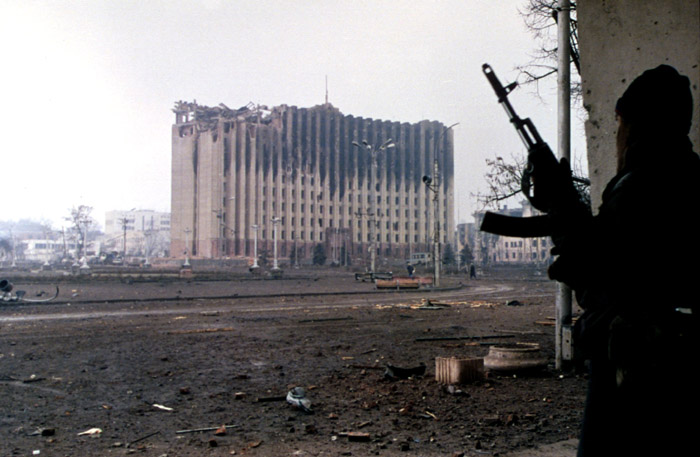Getting Serious About Syria: What to do When Containment Doesn't Work
Editor's Note: This piece was originally published on Markaz.
Published by The Lawfare Institute
in Cooperation With

Editor's Note: This piece was originally published on Markaz.
The breathless reports this weekend that a ceasefire for Syria had been reached "in principle" reveal once again how unrealistic our thinking has become about this particular national security issue. If a temporary ceasefire can help get food to the starving, that is excellent news. Beyond that, however, it is almost certain that there can be no lasting cessation of hostilities. Indeed, I would venture to go further and argue that peace negotiations are actually dangerous and counterproductive, because they make us feel that current policy has a realistic chance at success when in fact it does not.
Those who have favored minimizing the U.S. role in Syria and trying to contain the problem need to be empirical and recognize that their counsel has become part of the problem too. Containment has in effect been tried and failed. ISIS now has affiliates in at least eight countries; the Syrian civil war has killed nearly half a million and displaced more than ten million; U.S. intelligence considers a Paris-like attack here in the United States to be increasingly likely; America's key Middle East allies like Turkey, Jordan, and Iraq remain besieged—and in some cases existentially threatened—by the extremism and civil wars that have engulfed them.
No U.S.-led invasion with 100,000 troops makes sense, and President Obama is persuasive when he makes that argument. But he is attacking a strawman when he implies that the only alternative to our current very limited engagement is another massive American military undertaking in the Middle East.
Step-by-step
To be successful, we will need to do three things that collectively reduce the current mismatch between means and ends—between our aspirations and the reality of a stable Syria, and broader Middle East, that we seek to achieve:
-
Whatever elements of a moderate opposition that we can find to work with must be militarily strengthened and assisted much more than is the case today. This will probably require 500 or 1,000 American advisors on the ground—rather than 50—in carefully chosen parts of Syria. It will also necessitate an increase in direct military assistance to opposition groups beyond the miserly amounts we have been providing.
I do not favor employing no-fly zones in ways that could risk a conflict with Russia. We could, however, retaliate against Syrian government planes that attacked civilian populations and moderate militias, at places and times of our choosing, as an added element of such a policy.
-
Our political vision of a future Syria needs to change to a confederal model, and we need to encourage parties to the peace talks to see this as the most promising construct for a stable country. A strong, unified state is almost certainly no longer possible, at least for the foreseeable future. The enmities are too deep, and the distrust too profound. Moreover, President Bashar Assad does not wish to step down from power and, with Russia and Hezbollah at his side, sees no reason to do so.
Meanwhile, the Sunnis who oppose his rule will never again accept living under the thumb of a monster who has barrel-bombed their neighborhoods, used food as a weapon against their children, and killed at least 300,000 of their fellow Sunni Syrians while displacing millions more. Sunni-majority states in the region will not tolerate it either. We are thus stuck between a rock and a hard place.
The only logical escape from this contradiction would seem to be a compromise that tolerates having Assad rule over some parts of Syria—largely, the Alawite and Christian parts—while creating autonomous, self-governing and self-policing zones for other major groups. Minority rights would be protected in each zone, but those who felt unsafe as Shiite in a Sunni region or vice versa could be helped to relocate. Of course, ISIS and al-Nusra will need to be defeated—they cannot be allowed regions of their own. And the Western world would not provide economic recovery assistance to the Alawite-Christian sector until Assad did indeed step down, as a matter of principle (which could mean waiting for many years, of course). In the interim, that sector would have to get by with help only from Russia and Iran.
-
Finally, we need to recognize that a muscular international peace enforcement operation will almost surely be needed to uphold any deal that ultimately becomes possible, perhaps in 2017 or 2018, once we adopt the above two changes to our existing approach. Such a deal would have to include some fraction of Syria's big multiethnic cities—Aleppo, Homs, and/or Hama—within a Sunni Arab zone (Assad and his supporters could not have all the jewels in the nation's crown for themselves). That kind of outcome would presumably become more negotiable as power balances improved in the opposition's favor over time.
While it would be better not to have them involved, the Russians could stay if they insisted—and help police the Alawite-Christian (Assad) sector. The United States, with NATO allies, will need to play a role, as will the Arab League. Without such a force, which might have to number 50,000 or more at first and perhaps even 100,000 (with 10 to 20 percent of the total likely American forces), any ceasefire will almost surely founder. Roughly half of all ceasefires or peace deals ending civil wars fail to sustain the peace. Syria is an especially difficult and fraught case in light of the numerous groups, multiple outside powers with agendas of their own, and an extreme degree of human suffering that has exacerbated hatreds and distrust. With a confederation model of governance, however, in which autonomous regions are unified only through a weak umbrella government, the demands on a peacekeeping mission would be less onerous than if they literally had to try to put Humpty Dumpty back together again as a strong unitary state.
Once it becomes apparent in coming days that—as is almost surely inevitable—any ceasefire in Syria will be short-lived, we need to get beyond our twin delusions: that we have a serious Syria policy today, and that our current largely hands-off approach that seeks to contain the problem is viable. Such thinking is making the United States oblivious to the slow-motion genocide of our day. It is also allowing strategic risks to our allies and our own homeland, already significant, to grow each year. We need to get serious about Syria. It is too late for President Obama to solve the problem on his watch, but it is not too late to begin the process.




.jpg?sfvrsn=d5e57b75_5)
